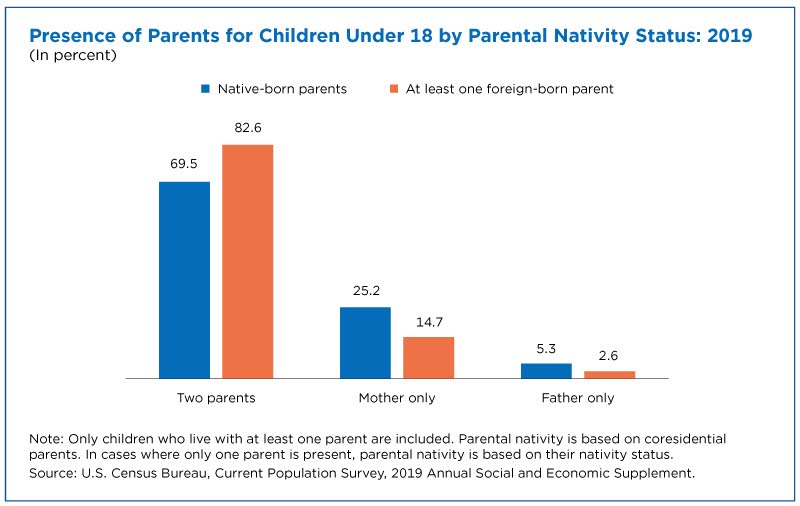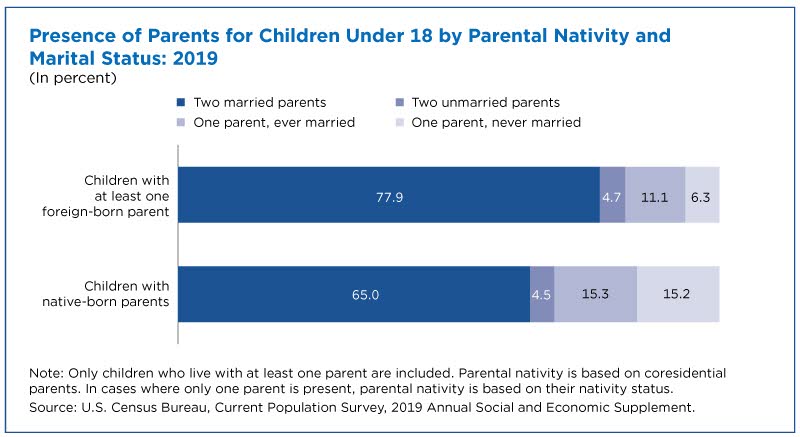Children Living with at Least One Foreign-Born Parent More Likely to Live with Two Parents than Children with Native-Born Parents
Children who lived with at least one foreign-born parent in 2019 had different characteristics than children who lived with native-born parents. Those with at least one foreign-born parent were more likely to live with two parents but didn’t fare as well economically.
While the majority of children under 18 in the United States lived with native-born parents in 2019 (69.7%), over a quarter (26.3%) lived with at least one foreign-born parent, according to a new U.S. Census Bureau report.
Regardless of nativity status, most children live with two parents, but children with at least one foreign-born parent (82.6%) were more likely to live with two parents in 2019 than children with native-born parents (69.5%).
The remaining 4% of children had no parents present. Among those with at least one foreign-born parent, the majority (87.7%) were native-born.
Presence of Parents
The living arrangements of children are diverse and vary across many characteristics, including parental nativity.
Regardless of nativity status, most children live with two parents, but children with at least one foreign-born parent (82.6%) were more likely to live with two parents in 2019 than children with native-born parents (69.5%).
Consequently, children with at least one foreign-born parent were less likely than children with native-born parents to live with either their mother only or their father only.
Parental Marital Status
Children with at least one foreign-born parent were also more likely than children with native-born parents to live with two married parents — 77.9% and 65.0%, respectively.
However, the percentage of children in these two groups who lived with two unmarried parents did not differ statistically.
Children with native-born parents were more likely than children with at least one foreign-born parent to live with one parent, regardless of whether the parent had ever married.
Among children with native-born parents, the percentage with only one parent who ever married did not significantly differ from the percentage with only one parent who never married.
Household Economic Characteristics
Children with native-born parents fared better on certain household economic characteristics than children with at least one foreign-born parent.
Those with at least one foreign-born parent, for example, were more likely than children with native-born parents to live below the poverty line (19.9% compared to 14.1%) and have no health insurance coverage (8.9% compared to 5.0%).
They were also more likely to live in a rented home: just under half (48.6%) compared to a third (33.1%) of children with native-born parents.
Although some household-level characteristics show that children living with at least one foreign-born parent were less economically secure, they also show that they were less likely to live in a household that received public assistance.
The recently released report is an update of a longstanding series on the living arrangements of children, first published in 1994.
The report uses data from the 2007 and 2019 Current Population Survey, Annual Social and Economic Supplements (CPS ASEC), 2008 and 2018 1-Year American Community Surveys (ACS), and 2014 Survey of Income and Program Participation (SIPP), Wave 1.
More information on confidentiality protection, methodology, sampling and nonsampling error, and definitions is available on this technical documentation page.
Related Statistics
Stats for Stories
Stats for Stories
Stats for Stories
Stats for Stories
Subscribe
Our email newsletter is sent out on the day we publish a story. Get an alert directly in your inbox to read, share and blog about our newest stories.
Contact our Public Information Office for media inquiries or interviews.









